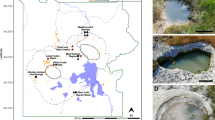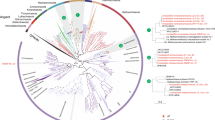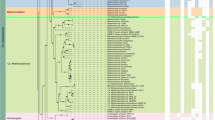Abstract
The preeminent source of biological methane on Earth is methyl coenzyme M reductase (Mcr)-dependent archaeal methanogenesis. A growing body of evidence suggests a diversity of archaea possess Mcr, although experimental validation of hypothesized methane metabolisms has been missing. Here, we provide evidence of a functional Mcr-based methanogenesis pathway in a novel member of the family Archaeoglobaceae, designated Methanoglobus nevadensis, which we enriched from a terrestrial hot spring on the polysaccharide xyloglucan. Our incubation assays demonstrate methane production that is highly sensitive to the Mcr inhibitor bromoethanesulfonate, stimulated by xyloglucan and xyloglucan-derived sugars, concomitant with the consumption of molecular hydrogen, and causing a deuterium fractionation in methane characteristic of hydrogenotrophic and methylotrophic methanogens. Combined with the recovery and analysis of a high-quality M. nevadensis metagenome-assembled genome encoding a divergent Mcr and diverse potential electron and carbon transfer pathways, our observations suggest methanogenesis in M. nevadensis occurs via Mcr and is fueled by the consumption of cross-fed byproducts of xyloglucan fermentation mediated by other community members. Phylogenetic analysis shows close affiliation of the M. nevadensis Mcr with those from Korarchaeota, Nezhaarchaeota, Verstraetearchaeota, and other Archaeoglobales that are divergent from well-characterized Mcr. We propose these archaea likely also use functional Mcr complexes to generate methane on the basis of our experimental validation in M. nevadensis. Thus, divergent Mcr-encoding archaea may be underestimated sources of biological methane in terrestrial and marine hydrothermal environments.
This is a preview of subscription content, access via your institution
Access options
Subscribe to this journal
We are sorry, but there is no personal subscription option available for your country.
Buy this article
- Purchase on Springer Link
- Instant access to full article PDF
Prices may be subject to local taxes which are calculated during checkout






Similar content being viewed by others
Data availability
Metagenome and 16S rRNA gene sequence data were deposited in the NCBI database as Bioproject PRJNA956542.
References
Pavlov AA, Brown LL, Kasting JF. UV shielding of NH3 and O2 by organic hazes in the Archean atmosphere. J Geophys Res Atmos. 2001;106:23267–87.
Zahnle KJ. Earth’s earliest atmosphere. Elements. 2006;2:217–22.
Arias P, Bellouin N, Coppola E, Jones R, Krinner G, Marotzke J, et al. Climate Change 2021: The physical science basis. Contribution of working group I to the sixth assessment report of the Intergovernmental Panel on Climate Change (IPCC). 2021; 2391.
Ellefson WL, Wolfe RS. Role of component C in the methylreductase system of Methanobacterium. J Biol Chem. 1980;255:8388–9.
Ermler U, Grabarse W, Shima S, Goubeaud M, Thauer RK. Crystal structure of methyl-coenzyme M reductase: the key enzyme of biological methane formation. Science. 1997;278:1457–62.
Hallam SJ, Putnam N, Preston CM, Detter JC, Rokhsar D, Richardson PM, et al. Reverse methanogenesis: testing the hypothesis with environmental genomics. Science. 2004;305:1457–62.
Evans PN, Parks DH, Chadwick GL, Robbins SJ, Orphan VJ, Golding SD, et al. Methane metabolism in the archaeal phylum Bathyarchaeota revealed by genome-centric metagenomics. Science. 2015;350:434–8.
Borrel G, Adam PS, McKay LJ, Chen LX, Sierra-García IN, Sieber CM, et al. Wide diversity of methane and short-chain alkane metabolisms in uncultured archaea. Nature Microbiol. 2019;4:603–13.
McKay LJ, Hatzenpichler R, Inskeep WP, Fields MW. Occurrence and expression of novel methyl-coenzyme Mreductase gene (mcrA) variants in hot spring sediments. Sci. Rep. 2017;7:7252.
Lynes MM, Krukenberg V, Jay ZJ, Kohtz AJ, Gobrogge CA, Spietz RL, et al. Diversity and function of methyl-coenzyme M reductase-encoding archaea in Yellowstone hot springs revealed by metagenomics and mesocosm experiments. ISME communications. 2023;3:22.
Hua Z-S, Wang Y-L, Evans PN, Qu Y-N, Goh KM, Rao Y-Z, et al. Insights into the ecological roles and evolution of methyl-coenzyme M reductase-containing hot spring Archaea. Nat Commun. 2019;10:4574–85.
Chen S-C, Musat N, Lechtenfeld OJ, Paschke H, Schmidt M, Said N, et al. Anaerobic oxidation of ethane by archaea from a marine hydrocarbon seep. Nature. 2019;568:108–11.
Hahn CJ, Laso-Pérez R, Vulcano F, Vaziourakis K-M, Stokke R, Steen IH, et al. ‘Candidatus Ethanoperedens,’ a thermophilic genus of Archaea mediating the anaerobic oxidation of ethane. mBio. 2020;11:e00600–e00620.
Laso-Pérez R, Wegener G, Knittel K, Widdel F, Harding KJ, Krukenberg V, et al. Thermophilic archaea activate butane via alkyl-coenzyme M formation. Nature. 2016;539:396–401.
Boyd JA, Jungbluth SP, Leu AO, Evans PN, Woodcroft BJ, Chadwick GL, et al. Divergent methyl-coenzyme M reductase genes in a deep-subseafloor Archaeoglobi. ISME J. 2019;13:1269–79.
Huber H, Jannasch H, Rachel R, Fuchs T, Stetter KO. Archaeoglobus veneficus sp. nov., a novel facultative chemolithoautotrophic hyperthermophilic sulfite reducer, isolated from abyssal black smokers. Syst Appl Microbiol. 1997;20:374–80.
Mori K, Maruyama A, Urabe T, Suzuki K-I, Hanada S. Archaeoglobus infectus sp. nov., a novel thermophilic, chemolithoheterotrophic archaeon isolated from a deep-sea rock collected at Suiyo Seamount, Izu-Bonin Arc, western Pacific Ocean. Int J Syst Evol Microbiol. 2008;58:810–6.
Beeder J, Nilsen RK, Rosnes JT, Torsvik T, Lien T. Archaeoglobus fulgidus isolated from hot North Sea oil field waters. Appl Environ Microbiol. 1994;60:1227–31.
Stetter KO, Lauerer G, Thomm M, Neuner A. Isolation of extremely thermophilic sulfate reducers: evidence for a novel branch of Archaebacteria. Science. 1987;236:822–4.
Bapteste É, Brochier C, Boucher Y. Higher-level classification of the Archaea: evolution of methanogenesis and methanogens. Archaea. 2005;1:353–63.
Liu Y-F, Chen J, Zaramela LS, Wang L-Y, Mbadinga SM, Hou Z-W, et al. Genomic and transcriptomic evidence supports methane metabolism in Archeoglobi. mSystems. 2020;5:e00651–19.
Takai K, Nakamura K, Toki T, Tsunogai U, Miyazaki M, Miyazaki J, et al. Cell proliferation at 122 °C and isotopically heavy CH4 production by a hyperthermophilic methanogen under high-pressure cultivation. Proc Natl Acad Sci USA. 2008;105:10949–54.
Hedlund BP, Thomas SC, Dodsworth JA, Zhang CL. Life in high-temperature environments. In: Manual of environmental microbiology. Washington, DC; ASM Press, 2015. p. 4.3.4–1–15.
Cole JK, Peacock JP, Dodsworth JA, Williams AJ, Thompson DB, Dong H, et al. Sediment microbial communities in Great Boiling Spring are controlled by temperature and distinct from water communities. ISME J. 2013;7:718–29.
Costa KC, Navarro JB, Shock EL, Zhang CL, Soukup D, Hedlund BP. Microbiology and geochemistry of great boiling and mud hot springs in the United States Great Basin. Extremophiles. 2009;13:447–59.
Vick TJ, Dodsworth JA, Costa KC, Shock EL, Hedlund BP. Microbiology and geochemistry of Little Hot Creek, a hot spring environment in the Long Valley Caldera. Geobiology. 2010;8:140–54.
Peacock JP, Cole JK, Murugapiran SK, Dodsworth JA, Fisher JC, Moser DP, et al. Pyrosequencing reveals high-temperature cellulolytic microbial consortia in Great Boiling Spring after in situ lignocellulose enrichment. PLoS ONE. 2013;8:e59927.
Buessecker S, Palmer M, Lai D, Dimapilis J, Mayali X, Mosier D, et al. An essential role for tungsten in the ecology and evolution of a previously uncultivated lineage of anaerobic, thermophilic Archaea. Nat Commun. 2022;13:3773–86.
Hanada S, Hiraishi A, Shimada K, Matsuura K. Chloroflexus aggregans sp. nov., a filamentous phototrophic bacterium which forms dense cell aggregates by active gliding movement. Int J Syst Evol Microbiol. 1995;45:676–81.
Kozich JJ, Westcott SL, Baker NT, Highlander SK, Schloss PD. Development of a dual-index sequencing strategy and curation pipeline for analyzing amplicon sequence data on the MiSeq Illumina Sequencing Platform. Appl Environ Microbiol. 2013;79:5112–20.
Callahan BJ, McMurdie PJ, Rosen MJ, Han AW, Johnson AJA, Holmes SP. DADA2: High-resolution sample inference from Illumina amplicon data. Nat Methods. 2016;13:581–3.
Langmead B, Salzberg SL. Fast gapped-read alignment with Bowtie 2. Nat Methods. 2012;9:357–9.
Antipov D, Korobeynikov A, McLean JS, Pevzner PA. hybridSPAdes: an algorithm for hybrid assembly of short and long reads. Bioinformatics. 2016;32:1009–15.
Kang DD, Li F, Kirton E, Thomas A, Egan R, An H, et al. MetaBAT 2: an adaptive binning algorithm for robust and efficient genome reconstruction from metagenome assemblies. PeerJ. 2019;7:e7359.
Arkin AP, Cottingham RW, Henry CS, Harris NL, Stevens RL, Maslov S, et al. KBase: The United States Department of Energy Systems Biology Knowledgebase. Nat Biotechnol. 2018;36:566–9.
Eren AM, Kiefl E, Shaiber A, Veseli I, Miller SE, Schechter MS, et al. Community-led, integrated, reproducible multi-omics with anvi’o. Nat Microbiol. 2021;6:3–6.
Parks DH, Imelfort M, Skennerton CT, Hugenholtz P, Tyson GW. CheckM: assessing the quality of microbial genomes recovered from isolates, single cells, and metagenomes. Genome Res. 2015;25:1043–55.
Chaumeil PA, Mussig AJ, Hugenholtz P, Parks DH. GTDB-Tk: a toolkit to classify genomes with the Genome Taxonomy Database. Bioinformatics. 2020;36:1925–7.
Richter M, Rosselló-Móra R, Glöckner FO, Peplies J. JSpeciesWS: a web server for prokaryotic species circumscription based on pairwise genome comparison. Bioinformatics. 2016;32:929–31.
Boyd JA, Woodcroft BJ, Tyson GW. GraftM: a tool for scalable, phylogenetically informed classification of genes within metagenomes. Nucleic Acids Res. 2018;46:e59.
Trifinopoulos J, Nguyen L-T, Haeseler von A, Minh BQ. W-IQ-TREE: a fast online phylogenetic tool for maximum likelihood analysis. Nucleic Acids Res. 2016;44:W232–W235.
Letunic I, Bork P. Interactive Tree Of Life (iTOL) v5: an online tool for phylogenetic tree display and annotation. Nucleic Acids Res. 2021;49:W293–W296.
Sander SP, Friedl RR, Barker JR, Golden DM, Kurylo MJ, Wine PH, et al. Chemical kinetics and photochemical data for use in Atmospheric Studies, Evaluation Number 1, 2009.
Yarnes C. δ13C and δ2H measurement of methane from ecological and geological sources by gas chromatography/combustion/pyrolysis isotope‐ratio mass spectrometry. Rapid Commun Mass Spectrom. 2013;27:1036–44.
Taylor CD, McBride BC, Wolfe RS, Bryant MP. Coenzyme M, Essential for growth of a rumen strain of Methanobacterium ruminantium. J Bacteriol. 1974;120:974–5.
Mayumi D, Mochimaru H, Tamaki H, Yamamoto K, Yoshioka H, Suzuki Y, et al. Methane production from coal by a single methanogen. Science. 2016;354:222–5.
Wang Y, Wegener G, Hou J, Wang F, Xiao X. Expanding anaerobic alkane metabolism in the domain of Archaea. Nat Microbiol. 2019;4:595–602.
Yoon S-H, Ha S-M, Lim J, Kwon S, Chun J. A large-scale evaluation of algorithms to calculate average nucleotide identity. Antonie Leeuwenhoek. 2017;110:1281–6.
Jain C, Rodriguez-R LM, Phillippy AM, Konstantinidis KT, Aluru S. High throughput ANI analysis of 90K prokaryotic genomes reveals clear species boundaries. Nat Commun. 2018;9:5114–22.
Hedlund BP, Chuvochina M, Hugenholtz P, Konstantinidis KT, Murray AE, Palmer M, et al. SeqCode: a nomenclatural code for prokaryotes described from sequence data. Nat Microbiol. 2022;7:1702–8.
Brüggemann H, Falinski F, Deppenmeier U. Structure of the F420H2:quinone oxidoreductase of Archaeoglobus fulgidus. Eur J Biochem. 2000;267:5810–4.
Welte C, Deppenmeier U. Membrane-bound electron transport in Methanosaeta thermophila. J Bacteriol. 2011;193:2868–70.
Duarte AG, Santos AA, Pereira IAC. Electron transfer between the QmoABC membrane complex and adenosine 5′-phosphosulfate reductase. Biochim Biophys Acta Bioenerg. 2016;1857:380–6.
Appel L, Willistein M, Dahl C, Ermler U, Boll M. Functional diversity of prokaryotic HdrA(BC) modules: role in flavin-based electron bifurcation processes and beyond. Biochim Biophys Acta Bioenerg. 2021;1862:148379.
Schoell M. Multiple origins of methane in the Earth. Chem Geol. 1988;71:1–10.
Gruen DS, Wang DT, Könneke M, Topçuoğlu BD, Stewart LC, Goldhammer T, et al. Experimental investigation on the controls of clumped isotopologue and hydrogen isotope ratios in microbial methane. Geochim Cosmochim Acta. 2018;237:339–56.
Taenzer L, Labidi J, Masterson AL, Feng X, Rumble D III, Young ED, et al. Low Δ12CH2D2 values in microbialgenic methane result from combinatorial isotope effects. Geochim Cosmochim Acta. 2020;285:225–36.
Luxem KE, Leavitt WD, Zhang X. Large hydrogen isotope fractionation distinguishes nitrogenase-derived methane from other methane sources. Appl Environ Microbiol. 2020;86:e00849–20.
Etiope G, Schoell M, Hosgörmez H. Abiotic methane flux from the Chimaera seep and Tekirova ophiolites (Turkey): Understanding gas exhalation from low temperature serpentinization and implications for Mars. Earth Planet Sci Lett. 2011;310:96–104.
Bradley AS, Summons RE. Multiple origins of methane at the Lost City Hydrothermal Field. Earth Planet Sci Lett. 2010;297:34–41.
Beulig F, Røy H, McGlynn SE, Jørgensen BB. Cryptic CH4 cycling in the sulfate–methane transition of marine sediments apparently mediated by ANME-1 archaea. ISME J. 2019;13:250–62.
Stewart LC, Algar CK, Fortunato CS, Larson BI, Vallino JJ, Huber JA, et al. Fluid geochemistry, local hydrology, and metabolic activity define methanogen community size and composition in deep-sea hydrothermal vents. ISME J. 2019;13:1711–21.
Topçuoğlu BD, Meydan C, Nguyen TB, Lang SQ, Holden JF. Growth kinetics, carbon isotope fractionation, and gene expression in the hyperthermophile Methanocaldococcus Jannaschii during hydrogen-limited growth and interspecies hydrogen transfer. Appl Environ Microbiol. 2019;85:e00180–19.
Topçuoğlu BD, Stewart LC, Morrison HG, Butterfield DA, Huber JA, Holden JF. Hydrogen limitation and syntrophic growth among natural assemblages of thermophilic methanogens at deep-sea hydrothermal vents. Front Microbiol. 2016;7:1240.
Ver Eecke HC, Akerman NH, Huber JA, Butterfield DA, Holden JF. Growth kinetics and energetics of a deep-sea hyperthermophilic methanogen under varying environmental conditions. Environ Microbiol Rep. 2013;5:665–71.
Kampik C, Liu N, Mroueh M, Franche N, Borne R, Denis Y, et al. Handling several sugars at a time: A case study of xyloglucan utilization by Ruminiclostridium cellulolyticum. mBio. 2021;12:e02206–21.
Klenk H-P, Clayton RA, Tomb J-F, White O, Nelson KE, Ketchum KA, et al. The complete genome sequence of the hyperthermophilic, sulphate-reducing archaeon Archaeoglobus fulgidus. Nature. 1997;390:364–70.
Vorholt J, Kunow J, Stetter KO, Thauer RK. Enzymes and coenzymes of the carbon monoxide dehydrogenase pathway for autotrophic CO2 fixation in Archaeoglobus lithotrophicus and the lack of carbon monoxide dehydrogenase in the heterotrophic A. profundus. Arch Microbiol. 1995;163:112–8.
Graham JE, Clark ME, Nadler DC, Huffer S, Chokhawala HA, Rowland SE, et al. Identification and characterization of a multidomain hyperthermophilic cellulase from an archaeal enrichment. Nat Commun. 2011;2:375–84.
Morita RY. Is H2 the universal energy source for long-term survival? Micro Ecol. 1999;38:307–20.
Donnelly MI, Dagley S. Production of methanol from aromatic acids by Pseudomonas putida. J Bacteriol. 1980;142:916–24.
Gunsalus RP, Wolfe RS. Stimulation of CO2 reduction to methane by methyl-coenzyme M in extracts of Methanobacterium. Biochem Biophys Res Commun. 1977;76:790–5.
Buchenau B, Thauer RK. Tetrahydrofolate-specific enzymes in Methanosarcina barkeri and growth dependence of this methanogenic archaeon on folic acid or p-aminobenzoic acid. Arch Microbiol. 2004;182:313–25.
Hedlund BP, McDonald AI, Lam J, Dodsworth JA, Brown JR, Hungate BA. Potential role of Thermus thermophilus and T. oshimai in high rates of nitrous oxide (N2O) production in ∼80 °C hot springs in the US Great Basin. Geobiology. 2011;9:471–80.
Sackett WM. Carbon and hydrogen isotope effects during the thermocatalytic production of hydrocarbons in laboratory simulation experiments. Geochim Cosmochim Acta. 1978;42:571–80.
Greensfelder BS, Voge HH, Good GM. Catalytic and thermal cracking of pure hydrocarbons: mechanisms of reaction. Ind Eng Chem. 1949;41:2573–84.
Birkeland PW, Janda RJ. Clay mineralogy of soils developed from Quaternary deposits of the eastern Sierra Nevada, California. Geol Soc Am Bull. 1971;82:2495–514.
Vanwonterghem I, Evans PN, Parks DH, Jensen PD, Woodcroft BJ, Hugenholtz P, et al. Methylotrophic methanogenesis discovered in the archaeal phylum Verstraetearchaeota. Nat Microbiol. 2016;1:16170.
Berghuis BA, Yu FB, Schulz F, Blainey PC, Woyke T, Quake SR. Hydrogenotrophic methanogenesis in archaeal phylum Verstraetearchaeota reveals the shared ancestry of all methanogens. Proc Natl Acad Sci USA. 2019;116:5037–44.
Reigstad LJ, Jorgensen SL, Schleper C. Diversity and abundance of Korarchaeota in terrestrial hot springs of Iceland and Kamchatka. ISME J. 2010;4:346–56.
Acknowledgements
We thank Marike Palmer for advice on systematics, Alma Parada for discussions about the computational approach, Alexander Jaffe for feedback on the manuscript, David and Sandy Jamieson for access to Great Boiling Spring, Alexander Manriquez for help with sampling at GBS, and Michael Morikone for initial metagenome analysis of the xyloglucan culture. We appreciate the CSUSB Genomics course of Spring 2018 for assistance with xyloglucan culture DNA extraction and long read sequencing.
Funding
Funding was provided by the National Science Foundation (NSF) grant DEB 1557042 and National Aeronautics and Space Administration (NASA) grant 80NNSC17KO548 and 80NSSC19M0150. SB was further supported by the NASA Postdoctoral Program (section Astrobiology), administered by Oak Ridge Associated Universities under contract with NASA. MEQ received critical funding from Stanford’s IntroSems Plus program for undergraduate students. GLC was supported by the Miller Institute for Basic Research in Science at U.C. Berkeley. Additional funding for metagenomes was provided by the U.S. Department of Energy’s Joint Genome Institute (DOE-JGI) under project 10.46936/10.25585/60007294 and DOE grant DE-EE0000716; the Nevada Renewable Energy Consortium, funded by the DOE.
Author information
Authors and Affiliations
Contributions
SB and AED developed the experimental design with input from BPH and JAD. SB conducted the experiments with assistance from MEQ. JAD achieved enrichment of M. nevadensis and has maintained the XG-degrading culture long-term. Metagenomic work was done by SB and GLC. GLC performed the metabolic inference and further enrichment of M. nevadensis. SB and JAD conducted field work at GBS. SB wrote the paper with contributions from GLC, BPH, and AED, and all authors edited the final version.
Corresponding authors
Ethics declarations
Competing interests
The authors declare no competing interests.
Additional information
Publisher’s note Springer Nature remains neutral with regard to jurisdictional claims in published maps and institutional affiliations.
Supplementary information
Rights and permissions
Springer Nature or its licensor (e.g. a society or other partner) holds exclusive rights to this article under a publishing agreement with the author(s) or other rightsholder(s); author self-archiving of the accepted manuscript version of this article is solely governed by the terms of such publishing agreement and applicable law.
About this article
Cite this article
Buessecker, S., Chadwick, G.L., Quan, M.E. et al. Mcr-dependent methanogenesis in Archaeoglobaceae enriched from a terrestrial hot spring. ISME J 17, 1649–1659 (2023). https://doi.org/10.1038/s41396-023-01472-3
Received:
Revised:
Accepted:
Published:
Issue Date:
DOI: https://doi.org/10.1038/s41396-023-01472-3



